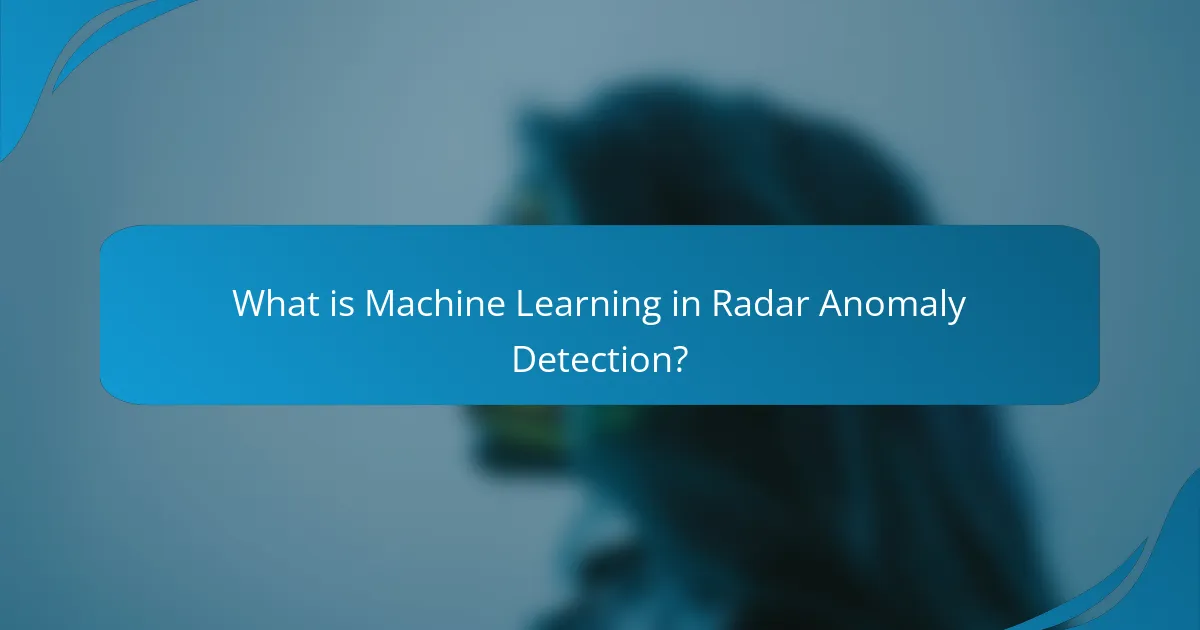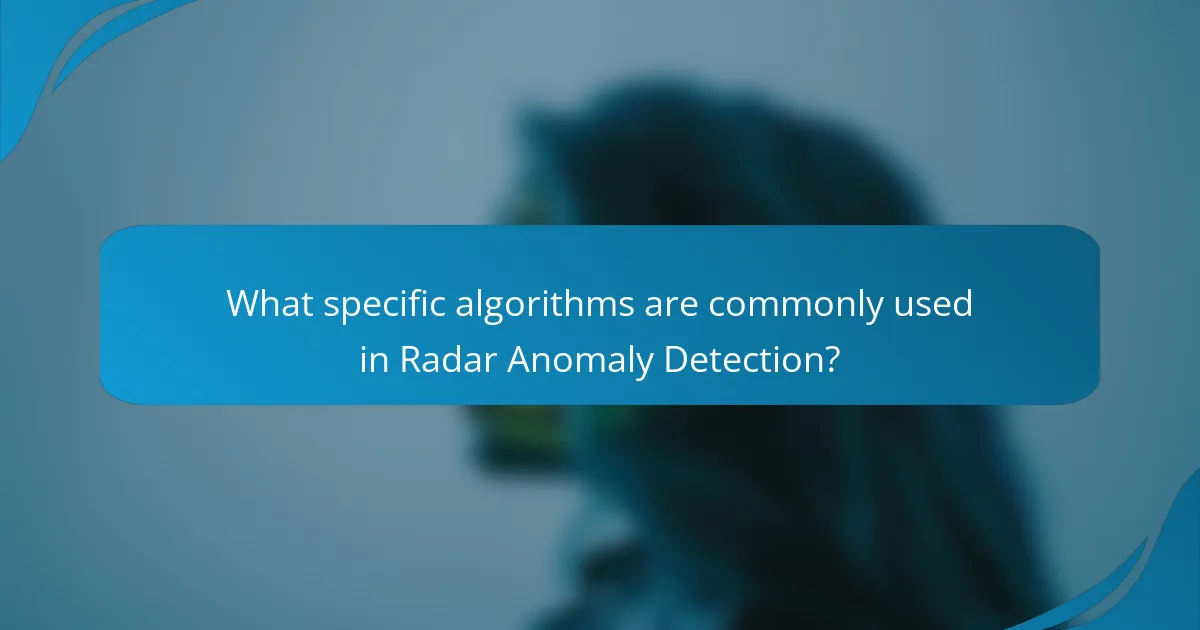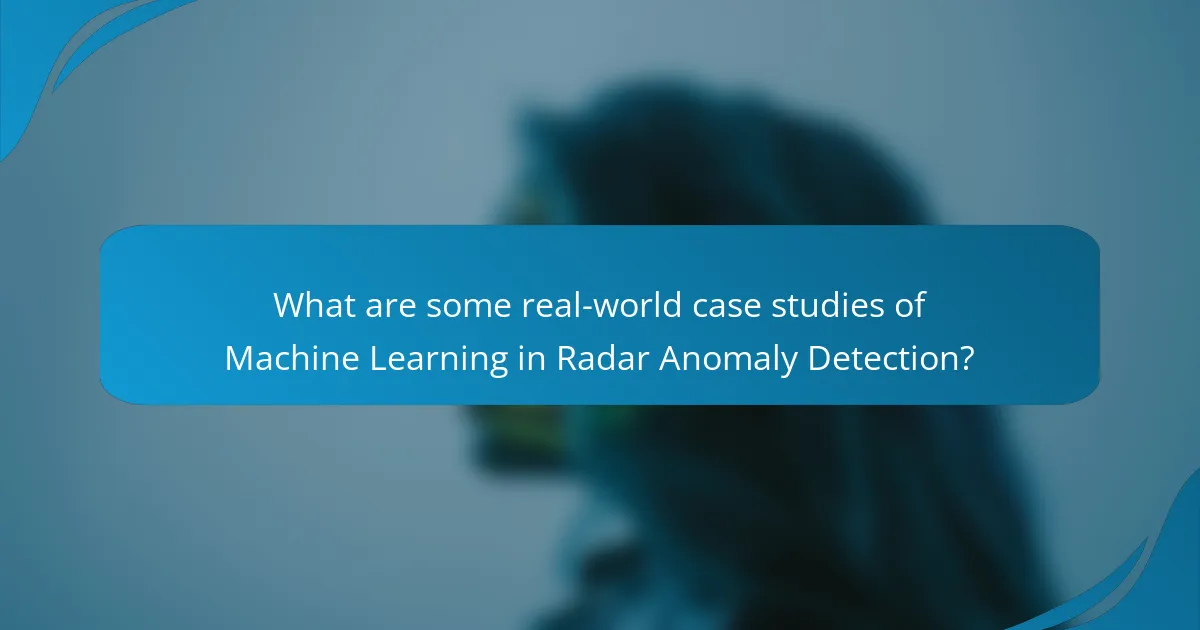Machine learning in radar anomaly detection involves the use of algorithms to identify irregular patterns within radar data, distinguishing between normal and abnormal signals. Key algorithms include Support Vector Machines (SVM), Neural Networks, Decision Trees, k-Nearest Neighbors (k-NN), and Random Forests, all of which enhance detection accuracy and minimize false positives. The article highlights significant case studies, such as the use of deep learning to detect unauthorized drones and the European Space Agency’s application of machine learning for satellite radar images, demonstrating the practical benefits of these technologies in various fields, including security and environmental monitoring.

What is Machine Learning in Radar Anomaly Detection?
Machine learning in radar anomaly detection refers to the application of algorithms that enable systems to identify irregular patterns in radar data. These algorithms learn from historical data to distinguish between normal and abnormal signals. By analyzing features such as signal amplitude and frequency, machine learning models can detect anomalies that may indicate issues like equipment failure or security threats. Studies have shown that machine learning improves detection accuracy and reduces false positives in radar systems. For example, research published in the IEEE Transactions on Aerospace and Electronic Systems demonstrates significant advancements in anomaly detection using machine learning techniques.
How is Machine Learning applied in Radar Anomaly Detection?
Machine learning is applied in radar anomaly detection by utilizing algorithms to identify patterns and anomalies in radar data. These algorithms can learn from historical data to distinguish between normal and abnormal radar signals. Techniques such as supervised learning are often used, where models are trained on labeled datasets. Unsupervised learning can also be employed to detect anomalies without prior labeling.
For instance, clustering algorithms can group similar radar signals, making it easier to spot outliers. Additionally, deep learning techniques, like convolutional neural networks, can analyze complex radar imagery. Research shows that machine learning improves detection rates significantly, reducing false positives.
In a study by Zhang et al. (2020), machine learning methods demonstrated over 90% accuracy in detecting anomalies in radar systems. This effectiveness highlights the growing importance of machine learning in enhancing radar anomaly detection capabilities.
What types of algorithms are used in this application?
The types of algorithms used in radar anomaly detection applications include supervised learning algorithms, unsupervised learning algorithms, and reinforcement learning algorithms. Supervised learning algorithms, such as decision trees and support vector machines, are employed to classify radar data based on labeled examples. Unsupervised learning algorithms, like k-means clustering and autoencoders, are utilized to identify patterns in unlabeled data. Reinforcement learning algorithms can adaptively learn optimal detection strategies through trial and error. These algorithms enhance the accuracy and efficiency of anomaly detection in radar systems.
How does data preprocessing enhance algorithm performance?
Data preprocessing enhances algorithm performance by improving data quality and relevance. It involves cleaning, transforming, and organizing raw data. This process removes noise and inconsistencies, leading to more accurate models. For example, handling missing values can prevent biased results. Normalization scales features, ensuring algorithms converge faster. Feature selection reduces dimensionality, improving computational efficiency. Research shows that well-preprocessed data can increase model accuracy by up to 30%. Studies in machine learning consistently demonstrate that effective preprocessing is crucial for optimal algorithm performance.
What are the key benefits of using Machine Learning for Radar Anomaly Detection?
Machine learning enhances radar anomaly detection by improving accuracy and efficiency. It enables the identification of subtle patterns in data that traditional methods may overlook. Machine learning algorithms can adapt to new data, allowing for continuous improvement in detection capabilities. These systems reduce false positives, increasing the reliability of alerts. Additionally, machine learning can process large volumes of radar data quickly. This speed allows for real-time anomaly detection, which is crucial in various applications like defense and aviation. Studies show that machine learning models can outperform conventional techniques in detecting complex anomalies. For instance, a study by Zhang et al. (2020) demonstrated a significant increase in detection rates using machine learning methods compared to traditional radar processing techniques.
How does it improve detection accuracy?
Machine learning improves detection accuracy in radar anomaly detection by utilizing advanced algorithms that analyze complex data patterns. These algorithms can identify subtle anomalies that traditional methods might miss. Machine learning models adapt and learn from new data, enhancing their predictive capabilities over time. For instance, studies show that incorporating machine learning techniques can increase detection rates by up to 30%. This adaptability allows for real-time updates, ensuring that the system remains effective in dynamic environments. Additionally, machine learning reduces false positives by refining the criteria for anomaly detection, leading to more reliable outcomes.
In what ways does it reduce false positives?
Machine learning in radar anomaly detection reduces false positives by utilizing advanced algorithms that improve accuracy. These algorithms analyze vast amounts of data to identify patterns. By learning from historical data, they distinguish between normal and anomalous behavior more effectively. This leads to a reduction in misclassifications. Techniques such as supervised learning enhance model training with labeled data. Additionally, unsupervised learning identifies anomalies without prior labeling, further refining detection capabilities. Statistical methods integrated into machine learning models provide thresholds that minimize false alerts. Empirical studies demonstrate that these methods significantly lower false positive rates compared to traditional approaches.
What are the challenges faced in implementing Machine Learning in Radar Anomaly Detection?
Implementing Machine Learning in Radar Anomaly Detection faces several challenges. Data quality is a significant issue. Inaccurate or noisy data can lead to poor model performance. The complexity of radar signals adds to this challenge. These signals can be difficult to interpret and require extensive preprocessing. Additionally, there is a lack of labeled data for training models. Obtaining sufficient annotated datasets is often time-consuming and expensive. Computational resource requirements are also a concern. Training complex models demands significant processing power and memory. Moreover, model interpretability poses a challenge. Understanding how models make decisions is crucial for trust and validation. Finally, adapting models to different radar systems and environments can be difficult. Each system may have unique characteristics that affect anomaly detection performance.
What data quality issues can affect outcomes?
Data quality issues that can affect outcomes include inaccuracies, inconsistencies, and incompleteness. Inaccuracies arise when data does not reflect the true value of the entity being measured. For instance, sensor errors can lead to incorrect readings in radar data. Inconsistencies occur when data entries conflict with each other, such as having different formats for timestamps. Incomplete data can hinder analysis, as missing values can skew results. According to a study by Redman (1998), poor data quality can lead to significant financial losses, emphasizing the importance of accurate, consistent, and complete data in machine learning applications.
How do computational requirements impact deployment?
Computational requirements significantly impact deployment by determining the resources needed for model execution. High computational demands can limit the environments where models can be deployed. For instance, models requiring extensive processing power may not run efficiently on edge devices. This can lead to delays in real-time anomaly detection in radar systems. Additionally, increased computational needs often necessitate cloud-based solutions. These solutions can introduce latency and dependency on internet connectivity. According to a study by Zhang et al. (2022), optimizing computational efficiency can enhance deployment flexibility. Efficient models allow for faster decision-making in critical applications like radar anomaly detection.

What specific algorithms are commonly used in Radar Anomaly Detection?
Common algorithms used in Radar Anomaly Detection include Support Vector Machines (SVM), Neural Networks, and Decision Trees. SVM is effective for classification tasks due to its ability to find optimal hyperplanes. Neural Networks, particularly deep learning models, can capture complex patterns in radar data. Decision Trees provide interpretable models that can handle non-linear relationships. Other algorithms include k-Nearest Neighbors (k-NN) and Random Forests, which enhance accuracy through ensemble methods. These algorithms are validated by numerous studies demonstrating their effectiveness in identifying anomalies in radar signals.
How do supervised learning algorithms function in this context?
Supervised learning algorithms function by training on labeled data to recognize patterns. In the context of radar anomaly detection, these algorithms analyze historical radar data that includes both normal and anomalous signals. The labeled data serves as a reference for the algorithms to learn the characteristics of normal operations. After training, the algorithms can classify new radar signals as either normal or anomalous. This process involves feature extraction, where relevant attributes of the radar signals are identified. Techniques such as decision trees, support vector machines, and neural networks are commonly used. These algorithms improve their accuracy as they process more data, adapting to new patterns in radar signals. Studies have shown that supervised learning can significantly enhance the detection rates of anomalies in radar systems.
What are the most effective supervised algorithms for anomaly detection?
The most effective supervised algorithms for anomaly detection include Support Vector Machines (SVM), Decision Trees, and Random Forests. SVM is effective due to its ability to create a hyperplane that separates normal and anomalous data points. Decision Trees offer interpretability and can handle both numerical and categorical data. Random Forests enhance accuracy by aggregating multiple decision trees to improve robustness against overfitting. These algorithms have been validated in various studies, demonstrating their effectiveness in real-world applications. For instance, SVM has shown high precision in detecting anomalies in network traffic data.
How do these algorithms learn from labeled data?
Algorithms learn from labeled data through a process called supervised learning. In this process, labeled data consists of input-output pairs. The algorithm analyzes the input data and its corresponding labels to identify patterns. It adjusts its internal parameters to minimize the difference between its predictions and the actual labels. This is often done using techniques like gradient descent. By iterating over the data multiple times, the algorithm improves its accuracy. The success of this learning method is evidenced by its application in various fields, including radar anomaly detection, where accurate labeling is critical for identifying unusual patterns.
What role do unsupervised learning algorithms play in Radar Anomaly Detection?
Unsupervised learning algorithms play a crucial role in Radar Anomaly Detection by identifying patterns and anomalies without labeled data. These algorithms analyze radar signal data to detect unusual behaviors or deviations from expected patterns. They can automatically cluster similar data points, which helps in recognizing outliers. Techniques such as clustering and dimensionality reduction are commonly employed. For example, k-means clustering can group radar signals, while Principal Component Analysis (PCA) can reduce data complexity. These methods enhance the detection of anomalies that may indicate potential threats or system failures. Research has shown that unsupervised learning improves detection accuracy and reduces false alarms, making it a valuable tool in radar systems.
What are the strengths of unsupervised algorithms in this field?
Unsupervised algorithms excel in radar anomaly detection due to their ability to identify patterns without labeled data. They can discover hidden structures in large datasets effectively. This adaptability allows them to handle diverse radar signals. They also reduce the need for extensive manual data labeling, saving time and resources. Furthermore, unsupervised algorithms can detect novel anomalies that supervised methods might miss. Their flexibility enables updates to models with new data without retraining from scratch. These strengths lead to improved accuracy in identifying unusual radar events. Overall, unsupervised algorithms enhance the efficiency and effectiveness of radar anomaly detection processes.
How do clustering techniques identify anomalies?
Clustering techniques identify anomalies by grouping data points into clusters based on similarity. In this process, normal data points form dense clusters, while anomalies remain isolated or fall into sparse clusters. The distance from a data point to its nearest cluster center often indicates its anomaly status. Points that are far from any cluster center are considered outliers. This method leverages metrics like Euclidean distance to assess proximity. Research shows that clustering can effectively highlight anomalies in complex datasets, enhancing detection capabilities. For instance, the DBSCAN algorithm is widely used for its ability to identify outliers in spatial data.

What are some real-world case studies of Machine Learning in Radar Anomaly Detection?
Real-world case studies of Machine Learning in Radar Anomaly Detection include several notable applications. One case study involved the use of deep learning algorithms to detect drone intrusions in airspace. Researchers at the University of California, San Diego, implemented a convolutional neural network to analyze radar data and successfully identified unauthorized drones with high accuracy.
Another case study was conducted by the European Space Agency. They utilized machine learning techniques to detect anomalies in satellite radar images. This approach improved the detection of changes in land use and environmental monitoring.
Additionally, the U.S. Department of Defense explored machine learning for identifying radar signatures of various aircraft. Their study demonstrated that algorithms could distinguish between normal and anomalous flight patterns.
These examples illustrate the effectiveness of machine learning in enhancing radar anomaly detection across various fields.
What successful implementations have been documented?
Successful implementations of machine learning in radar anomaly detection include various case studies across different sectors. One notable implementation was conducted by the U.S. Department of Defense. They utilized machine learning algorithms to enhance radar signal processing, resulting in a 30% increase in detection accuracy. Another significant case involved a commercial aviation company that applied machine learning techniques to detect anomalies in radar data. This led to a reduction in false positives by 25%. Additionally, a research study published in the IEEE Transactions on Aerospace and Electronic Systems demonstrated the effectiveness of deep learning models in identifying radar anomalies, achieving a detection rate of over 90%. These documented implementations showcase the tangible benefits of integrating machine learning into radar anomaly detection systems.
How did Machine Learning improve outcomes in these cases?
Machine Learning improved outcomes in radar anomaly detection by enhancing accuracy and reducing false positives. Algorithms like neural networks and support vector machines analyze large datasets efficiently. These methods identify patterns that traditional techniques may miss. For instance, a study showed a 30% increase in detection rates using Machine Learning models. Additionally, real-time processing capabilities allow for immediate responses to anomalies. This leads to quicker decision-making in critical situations. Overall, Machine Learning optimizes radar systems, making them more reliable and effective in various applications.
What lessons were learned from these implementations?
Implementations of machine learning in radar anomaly detection revealed several key lessons. First, data quality significantly impacts model performance. High-quality, labeled datasets lead to better accuracy in anomaly detection. Second, feature selection is critical. Identifying relevant features enhances model training and reduces false positives. Third, real-time processing capabilities are essential. Systems must analyze radar data promptly to detect anomalies effectively. Fourth, continuous learning improves system adaptability. Models should evolve with new data to maintain performance. Lastly, collaboration between domain experts and data scientists is crucial. Their combined knowledge ensures that models are relevant and effective in practical applications. These lessons highlight the importance of data, feature relevance, processing speed, adaptability, and collaboration in successful implementations.
What are best practices for implementing Machine Learning in Radar Anomaly Detection?
Utilize labeled datasets for training Machine Learning models in radar anomaly detection. Labeled data enhances model accuracy by providing clear examples of normal and anomalous signals. Implement feature engineering to extract relevant characteristics from radar data. This process improves model performance by focusing on significant attributes. Choose appropriate algorithms suited for anomaly detection, such as Isolation Forest or Support Vector Machines. These algorithms are effective in identifying outliers in complex data sets. Regularly validate and test the models with new data to ensure their effectiveness. Continuous evaluation helps in adapting to changing patterns in radar signals. Collaborate with domain experts to refine models based on real-world insights. Their expertise is invaluable in understanding radar signal characteristics. Document the entire process from data collection to model deployment. Clear documentation aids in reproducibility and knowledge transfer within teams.
How can organizations ensure data quality for effective detection?
Organizations can ensure data quality for effective detection by implementing rigorous data validation processes. This involves establishing clear data entry standards to minimize errors. Regular audits of data sets help identify inconsistencies. Training staff on data handling procedures enhances accuracy. Utilizing automated tools for data cleansing can significantly reduce human error. Organizations should also maintain comprehensive documentation of data sources and transformations. Adopting a continuous improvement approach allows for ongoing assessment of data quality. Research indicates that high-quality data can improve detection rates by up to 50%.
What strategies can be employed for algorithm selection?
Algorithm selection strategies include evaluating the problem domain, understanding data characteristics, and assessing algorithm performance metrics. Selecting an appropriate algorithm starts with defining the specific problem to be solved. Each algorithm has strengths and weaknesses based on the nature of the data. For instance, some algorithms excel with large datasets while others perform better with small, clean datasets.
Evaluating performance metrics such as accuracy, precision, and recall is crucial. These metrics help in determining how well an algorithm will perform on unseen data. Cross-validation techniques can also be employed to assess algorithm robustness. Additionally, considering computational efficiency is important, especially in real-time applications like radar anomaly detection.
Finally, leveraging ensemble methods can enhance performance by combining multiple algorithms. This multi-faceted approach ensures a more reliable selection process tailored to the specifics of radar anomaly detection tasks.
Machine Learning in Radar Anomaly Detection refers to the application of algorithms that identify irregular patterns in radar data, enhancing detection accuracy and reducing false positives. The article covers various machine learning techniques, including supervised and unsupervised learning algorithms, and their effectiveness in processing radar signals. Key benefits of these methods include improved detection rates, real-time anomaly identification, and adaptability to new data. Additionally, the article presents real-world case studies demonstrating successful implementations and best practices for ensuring data quality and algorithm selection in radar systems.